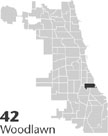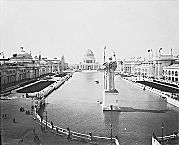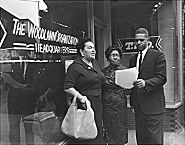| Entries |
| W |
|
Woodlawn
|
 Community Area 42, 7 miles SE of the Loop. Surrounded by Oakwoods
Cemetery
(1853),
Jackson Park
(1869), the Washington Park Race Track (1884), and the Midway Plaisance, the residential neighborhood of Woodlawn prospered when it could attract commercial enterprises within its limits.
Community Area 42, 7 miles SE of the Loop. Surrounded by Oakwoods
Cemetery
(1853),
Jackson Park
(1869), the Washington Park Race Track (1884), and the Midway Plaisance, the residential neighborhood of Woodlawn prospered when it could attract commercial enterprises within its limits.
Woodlawn Park's first residents were Dutch farmers who arrived in the 1850s. The population hovered between 500 and 1,000 until 1890. Woodlawn's farmers sent their produce to merchants in nearby Chicago on the Illinois Central Railroad, which opened a station on Junction Avenue (63rd Street) in 1862. By 1889, when Chicago annexed Woodlawn along with the rest of Hyde Park Township, residents had created several active civic organizations, including a Citizen's Improvement Club and the Woodlawn Businessmen's Association.

|
When the fair's closing dispersed the tourists, economic depression threatened Woodlawn's future. Local boosters promoted two commercial centers: the Washington Park Subdivision, with its amusement parks, racetrack, and beer gardens; and 63rd Street, where dozens of specialty shops attracted “ L ”-riding Chicagoans throughout the 1920s. The rest of Woodlawn was residential. University of Chicago faculty found the neighborhood congenial. When betting was outlawed in 1905, apartment houses replaced the racetrack in Washington Park. West Woodlawn, a trapezoidal subdivision in the southwest part of the neighborhood, attracted middle-class African Americans with the means to buy homes outside the nearby Black Belt.
The combination of racial succession and economic decline distressed local businessmen and officials of the University of Chicago, who organized to preempt the movement of poorer blacks east through the Washington Park Subdivision. In 1928, local landlords agreed to a joint restrictive covenant to keep nonwhites out of the subdivision. But the Great Depression made the higher rents blacks paid for illegally subdivided apartments a temptation to landlords. A lawsuit decided in the U.S. Supreme Court in 1940 found the covenant invalid, ratifying a demographic transformation already underway. In addition, 63rd Street's businesses began to fail, and taverns replaced furriers. In 1946 the Chicago Plan Commission designated Woodlawn eligible as a conservation area, but no plan was implemented. By 1960 Woodlawn had deteriorating, crowded housing and few commercial attractions to support a population that was 89 percent African American.

|
Despite TWO's organizational capacity and persistent proposals for economic renewal programs, Woodlawn's economy did not recover. Most white business owners, fearing repeats of the riots that devastated the West Side, left the neighborhood after the assassination of Martin Luther King, Jr. A rash of arsons destroyed a reported 362 abandoned buildings between 1968 and 1971. Unemployment, poverty, and crime climbed. Those who could afford to, moved out: Woodlawn's population declined from a high of 81,279 in 1960 to 27,086 in 2000. But the neighborhood's tradition of sophisticated civic action continued. In the early 1990s, community leaders began to bring private development, commercial enterprises, and a bank back to Woodlawn.
| Woodlawn (CA 42) | |||||
| Year |
Total
(and by category) |
Foreign Born | Native with foreign parentage | Males per 100 females | |
| 1930 | 66,052 | 15.0% | 26.7% | 97 | |
| 57,182 | White (86.6%) | ||||
| 8,578 | Negro (13.0%) | ||||
| 292 | Other (0.4%) | ||||
| 1960 | 81,279 | 1.8% | 0.3% | 94 | |
| 8,450 | White (10.4%) | ||||
| 72,397 | Negro (89.1%) | ||||
| 432 | Other races (0.5%) | ||||
| 1990 | 27,473 | 1.7% | — | 80 | |
| 879 | White (3.2%) | ||||
| 26,388 | Black (96.1%) | ||||
| 7 | American Indian (0.0%) | ||||
| 168 | Asian/Pacific Islander (0.6%) | ||||
| 31 | Other race (0.1%) | ||||
| 178 | Hispanic Origin* (0.6%) | ||||
| 2000 | 27,086 | 2.0% | — | 81 | |
| 821 | White alone (3.0%) | ||||
| 25,627 | Black or African American alone (94.6%) | ||||
| 42 | American Indian and Alaska Native alone (0.2%) | ||||
| 209 | Asian alone (0.8%) | ||||
| 7 | Native Hawaiian and Other Pacific Islander alone (0.0%) | ||||
| 75 | Some other race alone (0.3%) | ||||
| 305 | Two or more races (1.1%) | ||||
| 288 | Hispanic or Latino* (1.1%) | ||||
The Encyclopedia of Chicago © 2004 The Newberry Library. All Rights Reserved. Portions are copyrighted by other institutions and individuals. Additional information on copyright and permissions.